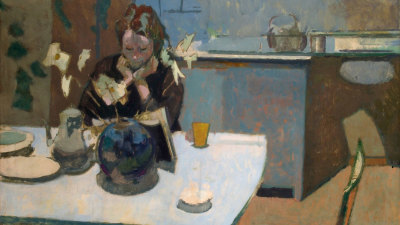Artist of the Month: May 2014
Artist of the Month: May 2014
Angelica Kauffman RA (1741-1807)
By the RA Collection team
Published 8 May 2014
Child prodigy Angelica Kauffman went on to be a founder-member of the Royal Academy. Her paintings and drawings were widely reproduced and were particularly popular in England, often being used in interior decorations.
-
Kauffman painted many self-portraits and often presented herself in various characters and guises. In this small etching she depicts herself leaning on a book, possibly to reflect her learning, and also introduces a column in the background, usually a symbol of fortitude or constancy. This work is unusual in that Kauffman etched the plate herself, which was not common during this period, and this adds to the direct and informal quality of the self-portrait.
Angelica Kauffman was born in Switzerland and was seen as a child prodigy. Her father, Joseph Johann Kauffman (1707-1782), an ecclesiastic muralist and portrait painter, oversaw her artistic training. She soon specialised in history subjects and portraits paintings while in Italy and was influenced by the emerging Neo-classical style. Kauffman became a member of the Roman Accademia di San Luca at the age of 23 shortly before coming to London. She arrived in June 1766 and remained there for 15 years before moving back to Italy with her second husband the painter Antonio Zucchi (1726-1796). In London, she was a founder-member of the Royal Academy of Arts, one of only two women, the other being Mary Moser.
-

Angelica Kauffman RA, Self-portrait, 1770.
Etching. 18 X 14.5 cm. Photo: RA. © Royal Academy of Arts, London.
-
All her life, she enjoyed international patronage such as the family of George III in Britain, Grand Duke Paul and Prince Nikolay Yusupov in Russia, Queen Caroline of Naples and Emperor Joseph II of Austria among others. She died in Rome where her funeral was arranged by the Neo-classical sculptor Antonio Canova (1757-1822).
A set of the four ‘Elements of Art’ represented by female allegories of Invention, Composition, Design and Colour, which were commissioned by the Royal Academy in 1778 to decorate the ceiling of the Academy’s new Council Chamber in Somerset House and can now be seen in the Front Hall of the Royal Academy. The personifications can be interpreted as a characterisation of the theory of art as expressed in Reynolds’ Discourses on Art, which were originally delivered in the Council Chamber and then published in 1788.
-

Angelica Kauffman RA, Colour, 1778-80.
Commissioned from Angelica Kauffman RA, 1778-1780.
Oil on canvas. 130 x 150.3 x 2.5 cm. Photo: R.A./John Hammond. © Copyright protected.
-
Kauffmann depicts Colour as an unrestrained female stealing pigment from a rainbow. She is seated on a grassy ledge with a chameleon at her feet - her hair and costume are loose. In touch with nature, she is more intuitive than the figures of Design which is an imposing allegorical female dressed in white and pale red with a purple mantle, seated beside two Roman columns. The figure is copying a fragment of an Antique male nude statue, commonly called the Belvedere torso. The original statue was first documented in Rome in the 1430s and is now in the Vatican Museum, Rome. However a cast of this torso was in the Royal Academy’s Collection at the time of Kauffman’s commission and was for the use of the students of the Royal Academy Schools. This composition alludes to one of the cornerstones of artistic academic training at that period which focused on proportion, scale and form based on antique prototypes. This training was also echoed in Kauffman’s own study, which was based on copying Antique statues and the Renaissance great masters.
-

Angelica Kauffman RA, Design, 1778-80.
Commissioned from Angelica Kauffman RA, 1778-1780.
Oil on canvas. 130 x 150.3 x 25 cm. Photo: RA/John Hammond. © Copyright protected.
-
Angelica Kauffman’s pictures were particularly popular in England and were used in interior decorations such as murals and as designs painted on furniture in cooperation with the architect Robert Adam.
Her paintings and drawings were widely reproduced through engravings. This drawing, engraved in the same year it was executed, illustrates an ancient version of the Cinderella fairytale. The eagle, perched on a throne with a slipper in its mouth refers to the story of Rhodope, a Greek girl sold into slavery in Egypt. According to legend, the bird stole her slipper and dropped it at the feet of the Pharoah, Psammetichus. Struck by the shoe’s beauty he vowed to find its owner and marry her. The nude figure on the right is Fortuna, goddess of fate and fortune.
-

Angelica Kauffman RA, A scene from the story of Rhodope and King Psammetichus of Egypt, 1780.
Given by Leverhulme Trust, 1936.
Pen and ink and wash on cream laid paper. 18.7 X 15.4 cm. Photo: RA/John Hammond. © Royal Academy of Arts, London.
-
Angelica Kauffman’s Self Portrait is currently on display at the Bendigo Art Gallery, Victoria, Australia in the exhibition Genius and Ambition: The Royal Academy of Arts 1768-1914.
An exhibition about Angelica Kauffman RA and Mary Moser RA is at the Angelika Kauffmann Museum, Schwarzenberg until 26 October 2014.
See more by Angelica Kauffman RA in our Collection.







